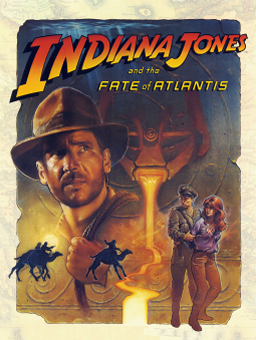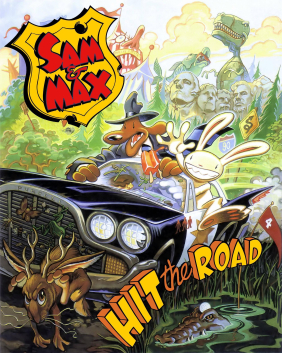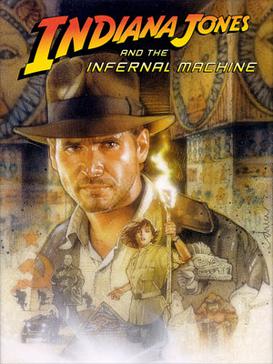
Lucasfilm Games is an American video game licensor and a subsidiary of Lucasfilm. It was founded in May 1982 by George Lucas as a video game development group alongside his film company; as part of a larger 1990 reorganization of the Lucasfilm divisions, the video game development division was grouped and rebranded as part of LucasArts. LucasArts became known for its line of adventure games based on its SCUMM engine in the 1990s, including Maniac Mansion, the Monkey Island series, and several Indiana Jones titles. A number of influential game developers were alumni of LucasArts from this period, including Brian Moriarty, Tim Schafer, Ron Gilbert, and Dave Grossman. Later, as Lucasfilm regained control over its licensing over the Star Wars franchise, LucasArts produced numerous action-based Star Wars titles in the late 1990s and early 2000s, while dropping adventure game development due to waning interest in the genre.

Indiana Jones and the Fate of Atlantis is a point-and-click adventure game developed and published by LucasArts and released in June 1992 for Amiga, DOS, and Macintosh. Almost a year later, it was reissued on CD-ROM as an enhanced "talkie" edition with full voice acting and digitized sound effects. The seventh game to use the script language SCUMM, Fate of Atlantis has the player explore environments and interact with objects and characters by using commands constructed with predetermined verbs. It features three unique paths to select, influencing story development, gameplay and puzzles. The game used an updated SCUMM engine and required a 286-based PC, although it still runs as a real-mode DOS application. The CD talkie version required EMS memory enabled to load the voice data.

Sam & Max Hit the Road is a graphic adventure video game released by LucasArts during the company's adventure games era. The game was originally released for MS-DOS in 1993 and for Mac OS in 1995. A 2002 re-release included compatibility with Windows. The game is based on the comic characters of Sam and Max, the "Freelance Police", an anthropomorphic dog and "hyperkinetic rabbity thing". The characters, created by Steve Purcell, originally debuted in a 1987 comic book series. Based on the 1989 Sam & Max comic On the Road, the duo take the case of a missing bigfoot from a nearby carnival, traveling to many American culture tourist sites to solve the mystery.

Hal Barwood is an American screenwriter, film producer, film director, game designer, game producer, and novelist.

Star Wars: Dark Forces is a first-person shooter video game developed and published by LucasArts. It was released in 1995 for MS-DOS and Macintosh, and in 1996 for the PlayStation. The story is set in the fictional Star Wars expanded universe and begins shortly before the original Star Wars film, before flashing forward to a year after the film's events. The game's protagonist and playable character is Kyle Katarn, a mercenary working on behalf of the Rebel Alliance who discovers the Galactic Empire's secret Dark Trooper Project, which involves the development of a series of powerful new battle droids and power-armored stormtroopers.

Titanic: Adventure Out of Time is a 1996 point-and-click adventure game developed by CyberFlix and published in the United States and United Kingdom by GTE Entertainment and Europress respectively, for Windows and Macintosh. It takes place in a virtual representation of the RMS Titanic, with the player assuming the role of a British spy who has been sent back in time to the final night of the Titanic and must complete a previously failed mission to prevent World War I, the Russian Revolution, and World War II from occurring. The gameplay involves exploring the ship and solving puzzles. There are multiple outcomes and endings to the game depending on the player's interactions with characters and use of items.

Star Wars: Force Commander is a real-time strategy video game released for the Microsoft Windows platform in 2000. It was co-developed by Ronin Entertainment and LucasArts, and published by LucasArts. Its plot interweaves between Star Wars: A New Hope and Return of the Jedi, taking place in key battles. Peter McConnell created remixed tracks of John Williams's original score with influences from hard rock and techno music.

Over one hundred video games based on the Star Wars franchise have been released, dating back to some of the earliest home consoles. Some are based directly on films while others rely heavily on the Star Wars Expanded Universe.

Star Wars Episode I: Racer is a 1999 racing video game based on the podracing sequence in the film Star Wars: Episode I – The Phantom Menace. The game features all of the racers and race course on Tatooine from The Phantom Menace. It adds several new courses, on Tatooine and various planets. It has several single player modes, including a tournament mode. The format of multiplayer mode varies by platform. Jake Lloyd and Lewis MacLeod, who portrayed Anakin Skywalker and Sebulba in The Phantom Menace, reprise their film roles in the game.

Indiana Jones and the Infernal Machine is an action-adventure video game by LucasArts released in 1999. The first 3D installment in the series, its gameplay focuses on solving puzzles, fighting enemies, and completing various platforming sections. The story is set in 1947, after the events of Indiana Jones and the Iron Phoenix, and puts the eponymous protagonist, the adventurer Indiana Jones, against the Soviet Union. In a race for a mythological Babylonian power source, he joins forces with the Central Intelligence Agency and collects four pieces of the Infernal Machine, an ancient device that allegedly opens a portal to another dimension.

Lego Star Wars II: The Original Trilogy is a 2006 Lego-themed action-adventure game developed by Traveller's Tales and published by LucasArts and TT Games Publishing. It was released on 11 September 2006. Part of the Lego Star Wars series, it is based on the Star Wars science fiction media franchise and Lego Group's Lego Star Wars construction toy line. It follows the events of the Star Wars films A New Hope, The Empire Strikes Back and Return of the Jedi. The game allows players to assume the roles of over 50 Lego versions of characters from the film series; customized characters can also be created. Camera movement was improved from its predecessor Lego Star Wars: The Video Game and the concept of "vehicle levels" was explored more thoroughly. The game was revealed at American International Toy Fair. Promotions for the game were set up at chain stores across the United States.

Indiana Jones and His Desktop Adventures is a 1996 adventure video game. Desktop Adventures was made to run in a windowed form on the desktop to limit memory use and allow the player to perform other tasks. This game was the first Desktop Adventures game, and was followed by Star Wars: Yoda Stories in 1997.

Star Wars Episode I: Obi-Wan's Adventures is a video game that chronicles the events of the film Star Wars: Episode I – The Phantom Menace from the character Obi-Wan Kenobi's perspective. It is the result of an agreement made in 2000 between the two video game publishers LucasArts and THQ. The agreement allows THQ to turn LucasArts licenses into games for the hand held console Game Boy Color, the first being Obi-Wan's Adventures. THQ published the game and HotGen developed it. It was released on December 6, 2000.

Lego Indiana Jones: The Original Adventures is a 2008 Lego-themed action-adventure video game developed by Traveller's Tales and published by LucasArts. Based on the Indiana Jones media franchise and the eponymous Lego Indiana Jones toy line. It follows the events of the first three Indiana Jones films: Raiders of the Lost Ark, The Temple of Doom, and The Last Crusade. It was released for Microsoft Windows, Nintendo DS, PlayStation 2, PlayStation 3, PlayStation Portable, Wii, Xbox 360, and Mac OS X.

Star Wars: Knights of the Old Republic (KOTOR) is a media franchise of space western role-playing video games created and developed by BioWare, which have seen releases on the original Xbox, Xbox 360, Microsoft Windows, OS X, Xbox One, Xbox Series X/S, IOS and Android. The franchise takes place in the fictional universe of Star Wars by George Lucas.
Star Wars: Jedi Knight is a series of first- and third-person shooter video games set in the fictional Star Wars expanded universe. The series focuses primarily on Kyle Katarn, a former Imperial officer who becomes a mercenary working for the Rebel Alliance, and later a Jedi and instructor at Luke Skywalker's Jedi Academy. While the first game is set a year after the events of A New Hope, the sequels take place in the decade following Return of the Jedi.
In video games, an open world is a virtual world in which the player can approach objectives freely, as opposed to a world with more linear and structured gameplay. Notable games in this category include The Legend of Zelda (1986), Grand Theft Auto III (2001) and Minecraft (2011).

Lego Indiana Jones 2: The Adventure Continues is a 2009 action-adventure video game developed by Traveller's Tales and published by LucasArts. Based on the Indiana Jones franchise, it is the sequel to the 2008 video game Lego Indiana Jones: The Original Adventures. It was released for the Wii, Xbox 360, PlayStation 3, and Microsoft Windows; Feral Interactive published a version for Mac OS X in 2011. TT Fusion developed a handheld version for the Nintendo DS and PlayStation Portable that, although released under the same name, is different in gameplay and amount of content.

Star Wars: Flight of the Falcon is a 3D first-person shooter video game developed by British company Pocket Studios and published by THQ for the Game Boy Advance in 2003. Based on the events of the original Star Wars trilogy of films, the game allows the player to pilot various space ships in the battles against the antagonistic Galactic Empire. The story follows the pilots of the space ship Millennium Falcon, Han Solo and his Wookiee co-pilot Chewbacca, as they help save the galaxy from the Empire's forces.


















